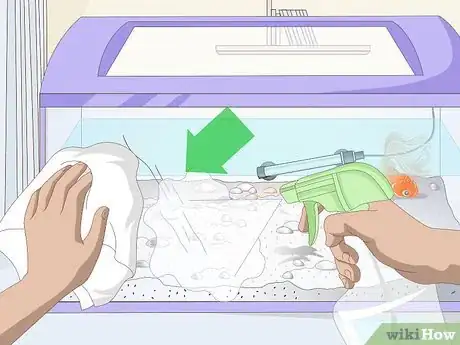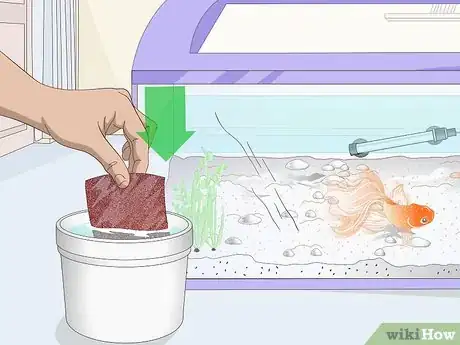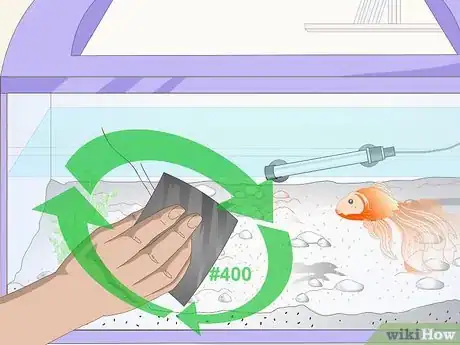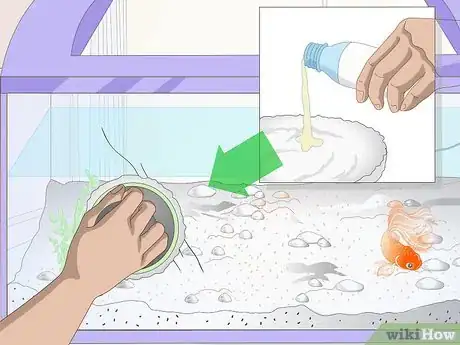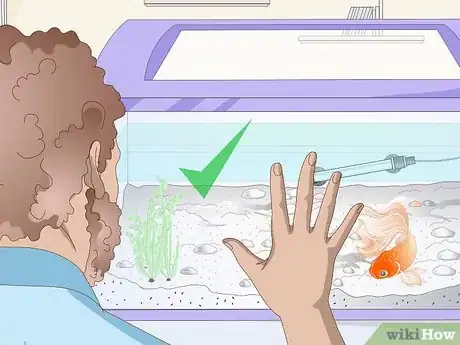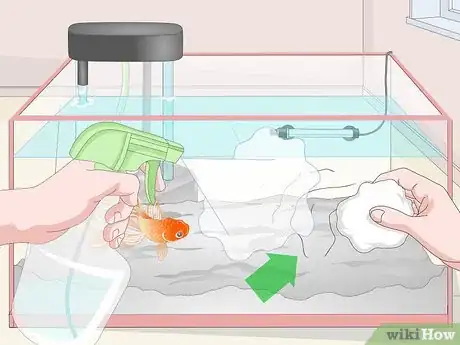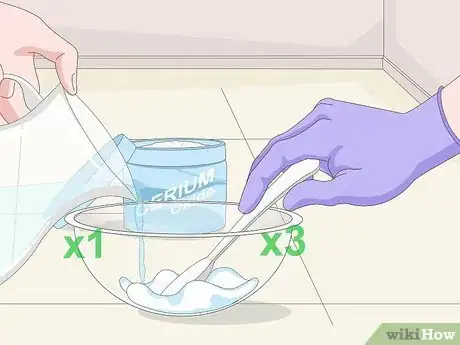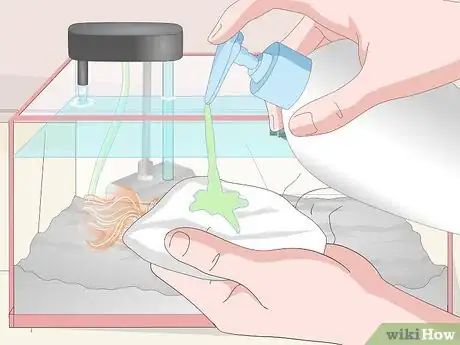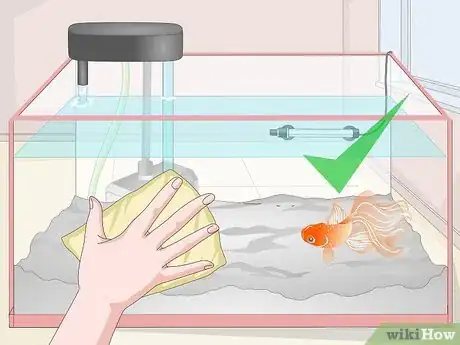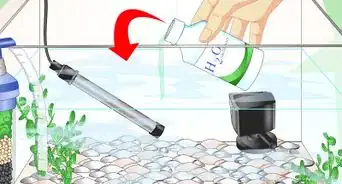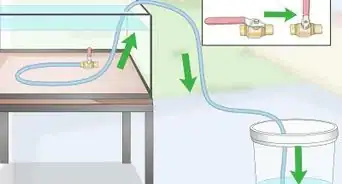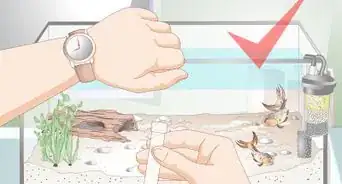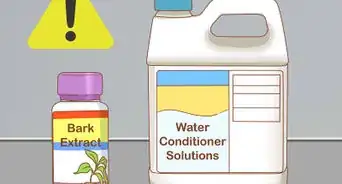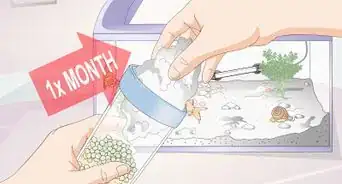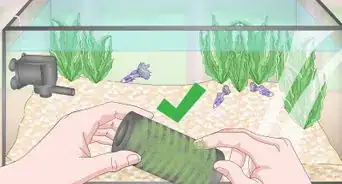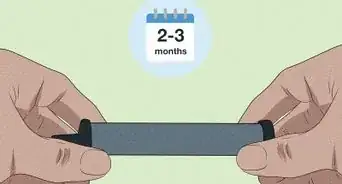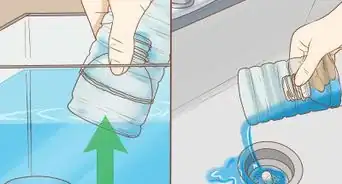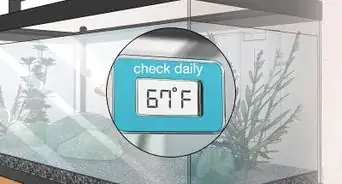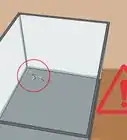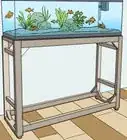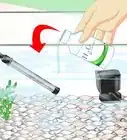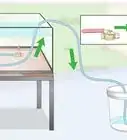This article was co-authored by Marshall Stephens. Marshall Stephens is an Aquarium Expert at Private Oceans Aquariums in West Palm Beach, Florida. Marshall has over 20 years of experience in the aquarium industry and focuses on captive-bred animals. They specialize in tropical and marine aquariums and are a contributor to the Loggerhead Marine life center in Jupiter Florida.
This article has been viewed 45,200 times.
Watching the fish swim in your aquarium is that much more enjoyable when the surface is scratch free. The colors of the fish against the reflection of the water through the glass is soothing and calming. A scratch is an eye sore, a constant reminder that you haven’t taken care of your aquatic home. Rest assured, however, that whether you have an acrylic or a glass aquarium, you can repair the unwanted scratches, and regain your beautiful view.
Steps
Repairing an Acrylic Aquarium
-
1Clean the outer surface. Spray the surface with acrylic safe cleaner. Use enough cleaner so that the surface is sufficiently wet. Wipe it clean with a soft cotton cloth, freeing it from dirt and dust. Work with a clean surface so you don’t add additional scratches as you work.[1]
- Wear rubber gloves while cleaning to protect your hands from the chemicals.
- Use only a clean soft cloth, rather than one of your sponges that already has cleaning products on it.
- Allow the surface to dry before continuing to the next step.
-
2Keep the surface cool. Dip your sandpaper in the bucket of water as you work. It's also important to wet down the surface, to keep it from getting too hot. Acrylic will melt at high temperatures. As you work, touch the aquarium surface cautiously, to make sure it isn't too warm. If it's hot to touch, take a break. Add water to the surface, allow it to cool, and then continue.Advertisement
-
3Use 400 grit sandpaper to smooth out the scratch. Work in circles. Remember to keep the paper wet. The surface should now feel smooth. Don't worry if the surface is hazy from the sandpaper creating tiny scratches. You will remove these with the polish.
- If the scratch is still visible, progress to 800, 1000, and then 2000 grit. The higher the grit, the finer the sandpaper.
-
4Buff out the scratch. Squeeze NOVUS plastic polish or acrylic polish onto a clean, soft towel. Work in a circular motion, polishing out the scratch until the surface is transparent again and like-new.
- Use an electronic buffer to save time, and your arm. Apply the polish to the buffer pad. Keep your tool at a low setting, and apply even pressure.[2]
-
5Let the tank surface dry. Check your work! Your tank should be clean and virtually scratch free.
Repairing a Glass Aquarium
-
1Clean the surface. Spray the surface with glass cleaner until the surface around the scratch is wet. Wipe down the outer surface of your glass aquarium, using a soft cotton cloth, freeing it from dirt and dust. Clean thoroughly and carefully, so you don't add more scratches as you work.[3]
- Wear new rubber gloves as you work to protect your hands from the chemicals.
- Avoid using old sponges or cleaning brushes. Use a new soft cloth to be sure you don't scratch the aquarium surface, or mix cleaning products.
- Wait for the surface to dry before moving on to the next step.
-
2Mix cerium oxide powder with water. Scoop 3 TBSP of the power into a small container and add 1 TBSP of water. It will form a paste. Dip the buffing pad into the slurry mixture to use with your electronic buffer. You can use this as a glass-polishing compound, or the brass polish below.[4]
- You can also purchase buffing kits on hardware stores.
-
3Squeeze brass or metal polish onto clean, dry, soft cloth or buffing pad. Start with a small amount, a dab, depending on the size of the scratch. Do not overuse the polish, as it may create more scratches. Used properly, as long as the scratch isn't too deep, this product will also remove the scratch, or make it a lot less noticeable.
-
4Buff out the scratch. Keep your tool on its lowest setting. Be sure it doesn't get too hot. Apply even pressure. Pause regularly to check the surface and your progress. Work until the scratch is removed.
-
5Wipe down the surface. Use a clean, soft cloth to carefully remove any polish. You're done! The scratch should now be gone, or at least less visible.
Expert Q&A
-
QuestionHow do you get rid of scratches on a fish tank?
 Marshall StephensMarshall Stephens is an Aquarium Expert at Private Oceans Aquariums in West Palm Beach, Florida. Marshall has over 20 years of experience in the aquarium industry and focuses on captive-bred animals. They specialize in tropical and marine aquariums and are a contributor to the Loggerhead Marine life center in Jupiter Florida.
Marshall StephensMarshall Stephens is an Aquarium Expert at Private Oceans Aquariums in West Palm Beach, Florida. Marshall has over 20 years of experience in the aquarium industry and focuses on captive-bred animals. They specialize in tropical and marine aquariums and are a contributor to the Loggerhead Marine life center in Jupiter Florida.
Aquarium Specialist Well, you need to buff it following the instructions above. For acrylic aquariums, look for a 3-part acrylic repair system. For glass, you can purchase a kit from your local hardware store.
Well, you need to buff it following the instructions above. For acrylic aquariums, look for a 3-part acrylic repair system. For glass, you can purchase a kit from your local hardware store.
Things You'll Need
Acrylic Aquarium:
- Small bucket of water
- Acrylic safe cleaner
- Soft cotton cloth
- Sandpaper (400 to 2,000 grit)
- Orbit sander
- Acrylic polish or NOVUS plastic polish
- Electronic buffer
Glass Aquarium:
- Soft cotton cloth
- Glass surface cleaner
- Small bucket of water
- Brass or metal polish, or Cerium Oxide powder
- Electronic buffer, power drill, or oscillation tool
- Buffing pad
Warnings
- If the scratch is on the inside, it’s better to leave it untouched and perhaps turn the aquarium so it doesn’t show as well. Use aquarium decor creatively to cover the scratch. The chemicals used to clean the aquarium are toxic for many fish and marine creatures.⧼thumbs_response⧽
Expert Interview
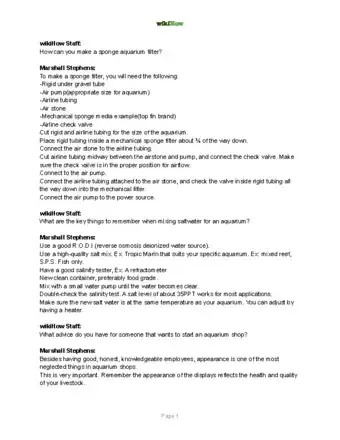
Thanks for reading our article! If you'd like to learn more about fixing an aquarium, check out our in-depth interview with Marshall Stephens.
References
About This Article
To fix scratches on an aquarium, first clean the outer surface with a soft, clean cloth and cleaner. If you have an acrylic aquarium, use 400 grit sandpaper to smooth out the scratch, but make sure to keep the surface cool by wetting the sandpaper first, or the acrylic could melt. Then, once the surface feels smooth from the sandpaper, buff out the scratch with a soft towel and acrylic polish. Alternatively, if you have a glass tank, you should squeeze brass or metal polish onto a clean cloth and use that to buff out the scratch, instead. For more advice, like how to create your own glass-polishing compound at home, read on.
